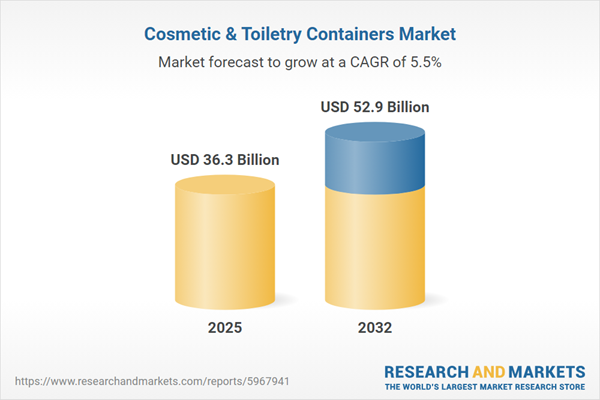Speak directly to the analyst to clarify any post sales queries you may have.
The cosmetic and toiletry containers market is experiencing substantial transformation, shaped by innovation in sustainable packaging, shifting consumer preferences, and technological advancements. Senior executives and strategic leaders need timely, actionable intelligence to remain competitive in this dynamic landscape.
Market Snapshot: Cosmetic and Toiletry Containers Market
According to recent analysis, the Cosmetic & Toiletry Containers Market grew from USD 34.38 billion in 2024 to USD 36.30 billion in 2025. Sustained demand and technological adoption are expected to fuel further expansion at a CAGR of 5.53%, with market value forecast to reach USD 52.90 billion by 2032. This surge highlights intensified global focus on eco-friendly design, compliance, and operational efficiency, inviting industry leaders to reevaluate strategies and investments accordingly.
Scope & Segmentation
- Container Types: Includes bottles, dispensers (pump, spray, valve), jars, sachets, and tubes—enabling application-specific functionality and product preservation.
- Material Types: Covers a range of materials: glass (amber, borosilicate, flint, soda lime), metal (aluminum, stainless steel, tinplate), plastic (HDPE, LDPE, PET, PP, PS, PVC), and silicone, reflecting the balance between performance, cost, and sustainability.
- Applications: Encompasses color cosmetics (eye makeup, foundation, lipstick), fragrances, hair care (conditioner, shampoo, treatments), oral care, and comprehensive skin care (body and facial products), reflecting diverse end-use scenarios.
- Distribution Channels: Spans drug stores, e-commerce (brand-owned and third-party platforms), specialty stores, supermarkets, and hypermarkets, ensuring broad market penetration across both established and emerging markets.
- Closure Types: Disc top, flip top, pump, screw cap, and spray cap solutions meet both functionality and branding requirements.
- Container Sizes: Ranges from below 50 ml to above 200 ml, aligning with varying consumer use-cases and regulatory guidelines for labeling.
- Regional Analysis: Detailed coverage of Americas (North & Latin America), Europe, Middle East & Africa, and Asia-Pacific, with deep dives into country-level trends and regulatory factors shaping regional demand.
- Key Companies Assessed: Major players examined include Amcor PLC, Berry Global Group, AptarGroup, Silgan Holdings, Gerresheimer AG, Crown Holdings, Owens-Illinois, Ardagh Group, Ball Corporation, and Toyo Seikan Group Holdings.
Key Takeaways for Strategic Decision-Makers
- Rapid shifts in consumer expectations are driving increased adoption of refillable systems, reusable containers, and smart packaging solutions featuring QR codes, NFC tags, and embedded sensors for personalized engagement and traceability.
- Manufacturers are integrating robotics, flexible production lines, and advanced material innovations such as bio-based polymers and recyclable composites, improving supply-chain agility and reducing environmental impact.
- Regulatory tightening on single-use plastics and volatile chemicals is compelling industry players to accelerate design-for-recyclability initiatives, increase collaboration within the supply chain, and proactively manage compliance risks.
- Digital transformation is enhancing production visibility, enabling customization at scale, and providing customers with direct access to prototyping tools and sustainability scorecards for deeper partnerships.
- Agile start-ups and established vendors alike are leveraging breakthrough barrier coatings and circular economy principles, positioning themselves as innovation partners to global brands.
- Regional dynamics vary, with North America and Europe focusing on sustainability and personalization, Asia-Pacific scaling production for both mass and premium segments, and EMEA engaging in consortium-led recycling efforts.
Tariff Impact: Navigating Policy Changes
Recent U.S. tariff adjustments on imported substrates and components have elevated costs across supply chains. This shift is prompting companies to reconsider sourcing strategies, favor domestic material suppliers, and explore near-shoring opportunities for cost stabilization. Investments in local material development and recycling are accelerating as organizations seek resilience and lower dependency on volatile international trade flows. Contractual frameworks and diversification of supply networks are emerging as key tactics to maintain competitive advantage amid changing trade environments.
Methodology & Data Sources
The research is underpinned by a rigorous combination of primary interviews with industry engineers, brand managers, and supply chain experts, along with secondary analysis sourced from trade publications, regulatory filings, and market databases. Quantitative models assess material adoption and cost sensitivities, while expert panels and real-world case studies validate strategic assumptions for accuracy and relevance.
Why This Report Matters: Empowering Senior Leaders
- Equips decision-makers with insights into evolving consumer demands, innovation trends, and regulatory risks within the cosmetic and toiletry containers market.
- Enables scenario planning by mapping emerging materials, digital manufacturing advancements, and regional shifts affecting procurement, compliance, and product design.
- Supports actionable strategic planning with validated recommendations on sustainability, operational resilience, and supplier portfolio optimization.
Conclusion
The cosmetic and toiletry containers market is evolving through digital transformation, sustainability initiatives, and responsive supply strategies. Equipped with this report, leaders can drive informed decisions and unlock pathways for responsible, profitable growth amid global change.
Additional Product Information:
- Purchase of this report includes 1 year online access with quarterly updates.
- This report can be updated on request. Please contact our Customer Experience team using the Ask a Question widget on our website.
Table of Contents
3. Executive Summary
4. Market Overview
7. Cumulative Impact of Artificial Intelligence 2025
Companies Mentioned
The companies profiled in this Cosmetic & Toiletry Containers market report include:- Amcor PLC
- Berry Global Group, Inc.
- AptarGroup, Inc.
- Silgan Holdings Inc.
- Gerresheimer AG
- Crown Holdings, Inc.
- Owens-Illinois, Inc.
- Ardagh Group S.A.
- Ball Corporation
- Toyo Seikan Group Holdings, Ltd.
Table Information
| Report Attribute | Details |
|---|---|
| No. of Pages | 183 |
| Published | November 2025 |
| Forecast Period | 2025 - 2032 |
| Estimated Market Value ( USD | $ 36.3 Billion |
| Forecasted Market Value ( USD | $ 52.9 Billion |
| Compound Annual Growth Rate | 5.5% |
| Regions Covered | Global |
| No. of Companies Mentioned | 11 |









